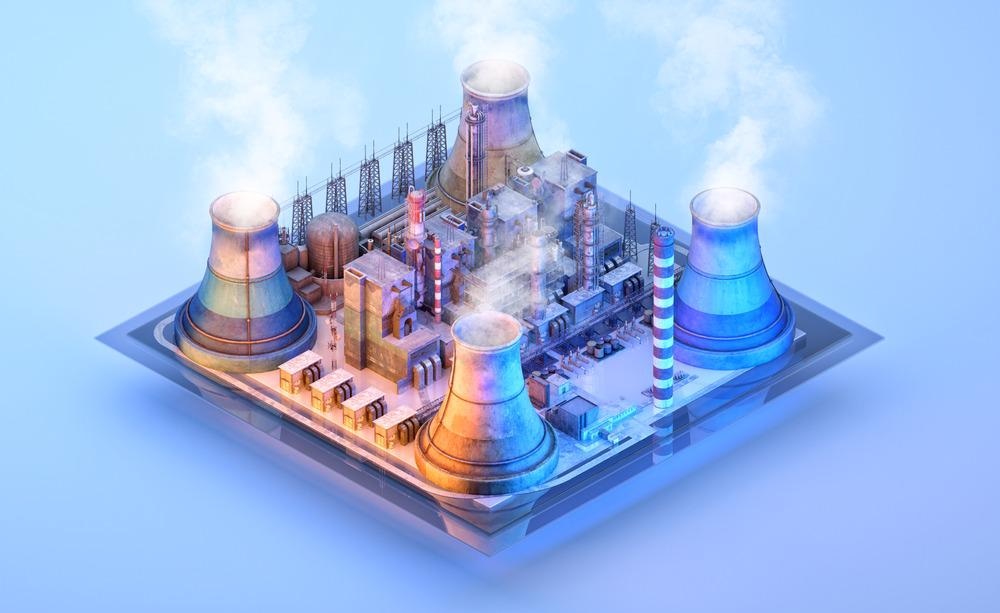
Image Credit: Corona Borealis Studio/Shutterstock.com
What is a Nuclear Reactor?
A nuclear reactor is the heart of a nuclear power plant which is used to initiate and control nuclear fission or fusion reactions.
A nuclear power reactor generates and regulates energy by splitting or fusing atomic nuclei. The energy released is utilized to generate steam and generate electric power without the emission of greenhouse gases. Nuclear energy (fission) is roughly 8,000 times more efficient than fossil fuel energy.
With over 440 commercial nuclear power facilities worldwide, nuclear power remains one of the most reliable carbon-free energy sources.
Generation II Nuclear Plant
Generation II refers to a category of commercial nuclear power reactors designed to be more cost-effective and reliable than the first generation of nuclear plants. They have a lifespan of approximately 40 years.
These nuclear reactors, also known as light water reactors, employ classic active safety elements, such as electrical or mechanical processes that can be launched automatically or by the operators themselves.
Some engineered systems, such as pressure relief valves, continue to operate and function even without operator control or auxiliary power.
This type of nuclear facility needs relatively large electrical grids and has a set of safety standards based on nuclear safety regulations. It generates enormous amounts of used fuel that must be disposed of in a high-level waste repository or reprocessed as part of a partially or fully closed fuel cycle.
Generation III Nuclear Plant
Generation III nuclear power plants are basically Gen II plants with advanced evolutionary design improvements. These improvements include fuel technology, modularized construction, thermal efficiency, safety measures, and standardization of design.
Generation III has a longer operational life, usually 60 years, until the reactor pressure vessel requires replacement or a major overhaul. Unlike Generation I and II nuclear power reactors, Generation III nuclear plants are subject to Nuclear Regulatory Commission (NRC) rules.
One of the first Generation III power reactors was the Westinghouse AP-600, a 600 MW advanced pressurized water reactor. General Electric's Advanced Boiling Water Reactor (ABWR) was also designed and gained a design certification from the Nuclear Regulatory Commission (NRC).
How is a Generation III Nuclear Plant Safer than a Generation II?
Passive Safety
Passive safety is a common element employed in Generation III nuclear facility designs. They do not require active controls or operational involvement in case of an accident. In the absence of electric power, they rely on natural convection, gravity, or resistance to high temperatures to keep things running smoothly.
In the Fukushima Daiichi disaster, the nuclear plant (Gen II) lost AC power and could not start the diesel generators necessary to cool the nuclear reactors. In a similar scenario, an advanced Generation III nuclear power plant would utilize natural circulation, gravity, and compressed gases to prevent overheating the containment and reactor core. Battery-powered systems would be utilized to maintain a secure shutdown until AC power is restored.
Core Catcher
A core catcher is included in the design of several Generation III and III+ (evolutionary advancement of Gen III nuclear reactors) nuclear power plants. If the fuel cladding, reactor vessel systems, and associated piping melt, corium (fuel-containing material) will fall into a reactor core catcher, which can hold and cool the molten material. As a result, the nuclear plant is protected.
Control Room Upgrades
The control room must be equipped with a dependable control system to operate the nuclear facility safely. The 1979 Three Mile Island nuclear power plant catastrophe showed that the safety of employees has to be prioritized while designing a control room.
Generation III nuclear reactors, such as the Advanced Boiling Water Reactor (ABWR), U.S. Advanced Pressurized-Water Reactor (US-APWR), and European Pressurized Reactor (EPR), include entirely digital control rooms built on human factors to increase operator engagement with systems and make operations and activities more user friendly.
In the event of a radioactive release, control rooms are provided with separate air tanks that connect to clean air delivery lines.
Advantages of Using Generation III Nuclear ReactorsThe standardized design of Generation III nuclear plants reduces construction time, maintenance, and capital expenditures. They are easier to run and less susceptible to operational disruptions due to their simplified and robust architecture.
They have greater availability and a lifespan of approximately 60 years. They have a substantial grace period in case of incidents so that the plant requires no active intervention for around 72 hours following closure. They utilize fuel more effectively and generate less waste.
Future Outlooks of Nuclear Energy
In the last 60 years or more, nuclear technology has advanced significantly. However, obstacles in safety, nonproliferation, the fuel cycle, and economics persist and may become increasingly difficult to overcome, particularly if breakthroughs in nuclear power reactor technology are not brought to market in the next two decades.
The demand for cheap and clean energy is growing with each passing year. As nuclear energy can generate low-carbon electric energy, it is the perfect replacement for fossil fuels. Hence, safe nuclear power production will establish the groundwork for unlimited clean energy.